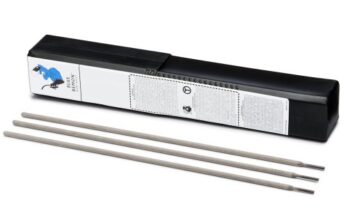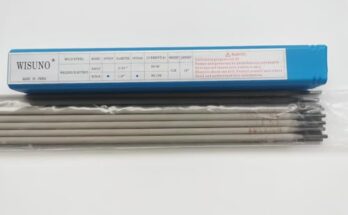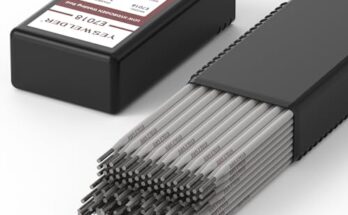Ever needed to weld in tough conditions? This guide will show you everything about the 7011 welding rod, a versatile tool for various applications. You’ll learn about its properties, uses, and how to use it effectively.
The 7011 welding rod is a type of low-hydrogen, iron-powder electrode used in shielded
metal arc welding (SMAW), often called stick welding. It’s known for its exceptional ability to weld in all positions (flat, vertical, overhead) and its strong performance on rusty or dirty metals. I’ve personally used 7011 rods on countless projects, from repairing farm equipment to fixing structural steel, and its versatility never ceases to impress me. Its core is composed of a mixture of iron powder and fluxing materials. This powder helps to create a stable arc and promotes penetration, while the flux protects the weld from atmospheric contamination. Unlike some other electrodes, 7011s are designed for use with AC (alternating current) and DC (direct current) power sources, making them exceptionally adaptable. This adaptability is a key reason for their widespread popularity among welders of all skill levels.
Key Features and Benefits of 7011 Electrodes
Several key features set 7011 welding rods apart. Their low-hydrogen composition minimizes the risk of hydrogen cracking in the weld, a common problem in high-strength steels. The iron powder in the electrode enhances the weld’s penetration, allowing you to create strong, robust joints even on thicker materials. The excellent arc stability minimizes spatter, resulting in a cleaner and more efficient welding process. I’ve noticed a significant difference in weld quality and speed compared to using other electrodes in difficult situations. Plus, the deep penetration provided by the 7011 means fewer passes are often needed, saving you both time and material costs. The versatility in welding positions is another major advantage, eliminating the need to constantly reposition the workpiece. You can consistently achieve strong, quality welds in any position – something truly appreciated when working on overhead structures or hard-to-reach areas. Finally, the electrode’s robust construction helps it tolerate minor interruptions in the welding arc, a frequent occurrence in outdoor or challenging environments.
7011 vs. Other Welding Rods: A Comparison
7011 rods aren’t the only game in town; other electrodes like 6010 and 6011 also offer excellent performance. However, 7011 rods distinguish themselves through their superior all-position capabilities and their ability to penetrate thicker materials more effectively. The 6010 electrode, while excellent for vertical down welding, struggles with overhead positions and often produces a less-robust weld bead. The 6011, similar to 7011, offers decent all-position capabilities but may lack the same penetration depth and arc stability. Consider this analogy: if you’re building a house, 6010 might be sufficient for the interior walls, but 7011 would be the preferred choice for the foundation, which needs superior strength and reliability. The choice ultimately depends on the specific welding application. For general-purpose applications where all-position welding and deep penetration are critical, the 7011 shines, whereas the other rods excel in specific niche situations.
Applications of 7011 Welding Rods
Welding on Various Metals
7011 electrodes are incredibly versatile and can be used to weld various steels, including mild steel, low-alloy steel, and even some high-strength steels. Their ability to weld rusty or dirty metals is a significant advantage in many real-world applications. I’ve personally used 7011s to repair old farm equipment where surface rust was a major concern. The electrode’s strong arc penetration cuts through the rust and creates a solid weld, eliminating the need for extensive pre-cleaning, which is both time-saving and cost-effective. The versatility extends to various thicknesses too. While best suited for thicker materials due to their penetration capabilities, they can be employed on thinner materials with careful technique. However, it’s crucial to adjust the amperage to avoid burning through thinner metals. This flexibility is a testament to its design, making it suitable for a broad range of projects and situations.
Typical 7011 Welding Projects
The applications for 7011 welding rods are vast. You’ll often find them used in construction, repair, and maintenance work. Think pipeline construction, where welding may occur in any position, or repairing heavy machinery out in the field, where clean metal isn’t always guaranteed. Other common applications include structural steel fabrication, automotive repair, and even some artistic metalwork. Their ability to handle outdoor welding, where wind and moisture can cause arc instability in other electrodes, makes them a favorite among field welders. The strength and durability of the 7011 weld make it suitable for applications that require high structural integrity, making it the go-to option for many professionals in various industries. It’s also important to note that proper safety precautions, including wearing appropriate PPE, are crucial when working with any welding electrode, including 7011.
Choosing the Right 7011 Welding Rod
Understanding Rod Diameters and Amperage
7011 rods come in various diameters, typically ranging from 1/16 inch to 5/32 inch. The diameter you choose depends on the thickness of the metal you’re welding and the amperage your welding machine can provide. Larger diameter rods require higher amperage and are suitable for thicker materials. Conversely, smaller diameter rods work well with thinner materials at lower amperage. Choosing the correct diameter and matching it to the proper amperage settings is key to achieving a high-quality weld. I’ve often started with a slightly lower amperage setting and gradually increased it until I found the optimal balance between penetration and weld bead control. Improper amperage settings can lead to weak welds, excessive spatter, or even burning through the metal. This is a fundamental aspect that every welder should understand.
Factors to Consider When Selecting a 7011 Rod
When choosing a 7011 rod, several additional factors should be taken into consideration. The coating formulation can vary slightly between manufacturers, impacting arc stability and penetration. Some formulations are better suited for specific applications or welding positions. Always check the manufacturer’s specifications to ensure the rod is suitable for your intended use. Another crucial factor is the rod’s storage and handling. Low-hydrogen electrodes, like 7011, are susceptible to moisture absorption. Proper storage in a dry, airtight container is essential to maintain their performance and prevent hydrogen cracking in the weld. Failure to do so can drastically compromise the weld quality and strength. Finally, always inspect the electrode for any defects before use. A damaged or compromised electrode can lead to inconsistent welds and may even cause injury. Prioritizing these key factors will improve your welding outcomes significantly.
7011 Welding Rod Techniques and Procedures
Proper Welding Technique for Optimal Results
Achieving a strong and clean weld with 7011 rods requires proper technique. Maintaining a consistent arc length is crucial for stable penetration and minimal spatter. The arc length should generally be about 1/8 inch to 3/16 inch. The welding speed also significantly impacts the weld quality. Too slow a speed can lead to excessive heat input and burn-through, while too fast a speed results in poor penetration. Practice is essential to find the right balance. I’ve always stressed the importance of practicing on scrap metal before tackling a real project. This allows you to refine your technique and understand how the electrode reacts to different amperage settings and welding speeds. Remember, consistency is key to producing high-quality welds.
Troubleshooting Common Problems with 7011
Even with the best technique, you might encounter occasional problems while welding with 7011 rods. Excessive spatter is a common issue that can usually be resolved by adjusting the amperage or arc length. Insufficient penetration might indicate a need for higher amperage or a slower welding speed. On the other hand, weld burn-through indicates you need a lower amperage or a faster welding speed. Understanding these relationships is key to troubleshooting. Poor arc stability could be due to a damaged electrode, moisture absorption, or improper power settings. Always check the electrode’s condition and ensure it’s properly stored before troubleshooting other potential issues. By systematically examining the potential causes, you’ll be able to quickly resolve most problems and achieve satisfactory welding results.
Safety Precautions When Using 7011 Welding Rods
Essential Safety Gear and Equipment
Welding with 7011 rods, or any welding process for that matter, requires strict adherence to safety protocols. Always wear appropriate personal protective equipment (PPE), including a welding helmet with a suitable shade lens (typically 10-12), welding gloves, and protective clothing that covers exposed skin. Ensure the area is well-ventilated to prevent inhalation of welding fumes. A respirator or welding mask might be necessary depending on the workspace and the welding task. Proper ventilation and respiratory protection is particularly important when working in enclosed spaces. Finally, always be aware of the surroundings and potential fire hazards. Keep a fire extinguisher nearby, and ensure that all combustible materials are safely removed from the welding area.
Avoiding Common Welding Hazards
Understanding the hazards associated with welding is essential for safe operation. Electric shock is a significant risk, especially when working with higher amperage settings. Ensure the welding equipment is properly grounded and that you use insulated tools. Ultraviolet (UV) radiation from the arc can cause serious eye damage, making a proper welding helmet crucial. Welding fumes can contain harmful substances, hence the importance of good ventilation and respiratory protection. Burns from hot metal spatter are also possible, so maintaining a safe distance and wearing protective clothing is paramount. Understanding these potential hazards and taking proactive steps to mitigate them is vital to ensuring a safe and productive welding experience. Regular maintenance of your welding equipment is also essential for preventing unexpected malfunctions and ensuring the safety of the operator.
7011 Welding Rod Storage and Maintenance
Proper Storage to Maintain Rod Quality
Storing 7011 rods correctly is essential to preserving their quality and performance. Low-hydrogen electrodes are hygroscopic, meaning they absorb moisture from the air. Excessive moisture can lead to hydrogen cracking in the weld, compromising the integrity of the joint. Therefore, always store 7011 rods in a sealed, airtight container in a dry location, away from sources of moisture and extreme temperatures. A dedicated welding storage cabinet or a sealed plastic container with desiccant packets is ideal. Regularly checking the storage container and replenishing desiccant packets as needed is crucial for maintaining the electrode’s quality. Proper storage significantly reduces the chance of encountering issues related to moisture absorption.
Inspecting and Maintaining Your Welding Equipment
Maintaining your welding equipment is vital not only for its longevity but also for ensuring safe operation. Regularly inspect the welding machine for any signs of damage or wear. Check the cables for fraying or damage and ensure all connections are secure. Keep the machine clean and free from debris. Proper cable management not only extends the life of the equipment but also minimizes the risk of accidental shorts or electrical hazards. Schedule regular maintenance checks, cleaning the machine’s ventilation system to prevent overheating and ensuring optimal performance. These measures significantly enhance the safety and reliability of your welding process, guaranteeing consistent weld quality and preventing costly downtime.
Advanced Techniques and Applications
Using 7011 for Out-of-Position Welding
One of the defining features of the 7011 electrode is its excellent performance in all welding positions. However, mastering out-of-position welds requires specific techniques. For vertical-up welding, a fast weaving motion helps to prevent excessive heat buildup and ensures proper penetration. In overhead welding, the key is to maintain a short arc length and a consistent welding speed. Practice is key to achieving good penetration and smooth weld beads. It’s important to find a welding speed that provides sufficient penetration without producing excessive heat buildup. Overhead welding demands a controlled, steady hand and good awareness of the molten weld pool.
7011 Welding on Different Material Thicknesses
The choice of electrode diameter and amperage is crucial when welding different material thicknesses using 7011 rods. Thicker materials typically require larger diameter electrodes and higher amperage settings to ensure adequate penetration. Conversely, thinner materials might require smaller diameter electrodes and lower amperage settings to prevent burn-through. The welding speed should also be adjusted accordingly. It’s a balance between getting enough penetration and preventing excessive heat input. I’ve always recommended practicing on scrap material of similar thickness to refine your technique before tackling any production weld. Proper control of the arc length, speed, and current ensures the creation of a strong and aesthetically pleasing weld.
Choosing the Right Welding Machine for 7011
Matching Power Source and Amperage Capabilities
7011 electrodes are compatible with both AC and DC welding machines. However, the choice of power source and amperage range can impact the welding performance. DC-positive (DC+) connections tend to produce a deeper penetration, often preferred for thicker materials. DC-negative (DC-) connections can improve arc stability and reduce spatter, which might be advantageous for thinner materials or out-of-position welding. The amperage range of your welding machine must match the recommended amperage for the electrode diameter. A machine with insufficient amperage will struggle to provide the needed penetration, resulting in weak welds. Conversely, excessive amperage can lead to burn-through or excessive spatter. Matching these aspects correctly guarantees the best possible welding results.
Frequently Asked Questions
What is 7010 welding rod best for?
7010 electrodes are designed for vertical down welding, usually on thinner materials. While very strong, they’re not designed for overhead or other positions. Learn more about 7010 rods to better understand their niche applications.
What is 7011 welding rod best for?
The 7011 welding rod is ideal for all-position welding on various steel types, particularly in applications where deep penetration is required and the metal may be rusty or dirty. Its versatility makes it a go-to choice for many professionals.
What kind of current does a 7011 welding rod use?
7011 electrodes are compatible with both AC (Alternating Current) and DC (Direct Current) power sources, offering excellent flexibility. The choice of DC+ or DC- can influence penetration and spatter, so understanding these nuances is important.
Can I use 7011 welding rod on aluminum?
No, 7011 rods are not suitable for welding aluminum. Aluminum requires a different type of electrode and welding process due to its distinct properties and melting point. You’d need a filler material specifically designed for aluminum welding, along with the appropriate equipment.
What is the difference between 7011 and 6011 welding rods?
Both 7011 and 6011 are all-position electrodes, but 7011 offers superior penetration and arc stability. 6011 is more forgiving for less-skilled welders. The 7011 is the better choice for more demanding applications requiring higher strength and reliability.
How do I store 7011 welding rods properly?
Store 7011 rods in a sealed, airtight container in a dry place to prevent moisture absorption. Moisture can cause hydrogen cracking, leading to weakened welds. Consider using desiccant packs to further protect them from moisture.
What safety precautions should I take when using 7011 welding rods?
Always wear appropriate PPE including a welding helmet, gloves, protective clothing, and respiratory protection. Ensure adequate ventilation, and keep a fire extinguisher handy. Be aware of electric shock, UV radiation, and burns from hot spatter.
Final Thoughts
The 7011 welding rod is a truly versatile tool that any welder should understand. Its ability to perform well in all positions, weld on various metals, and penetrate thick materials makes it essential for a wide range of applications. Mastering the proper techniques, safety precautions, and storage practices is vital to unlocking its full potential. While there’s a learning curve, the rewards of strong, reliable welds are well worth the effort. From repairing farm equipment to constructing steel structures, the 7011 rod consistently delivers. So, whether you’re a beginner or an experienced welder, understanding the intricacies of the 7011 rod will significantly enhance your welding skills and project outcomes.


